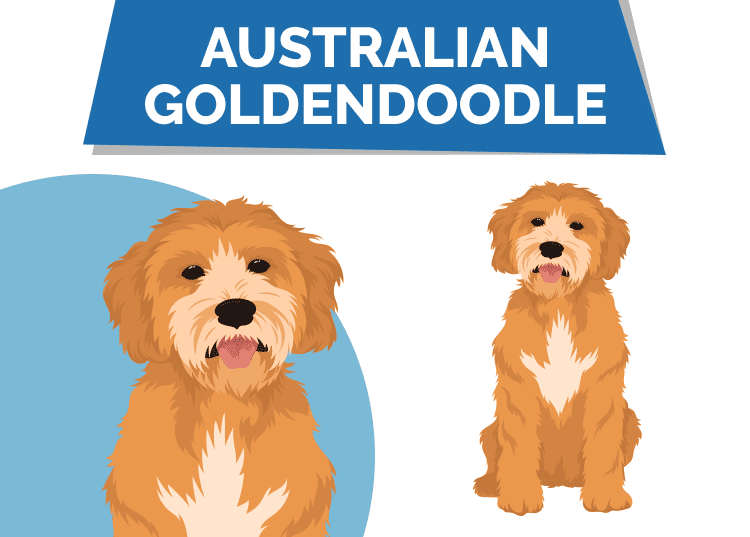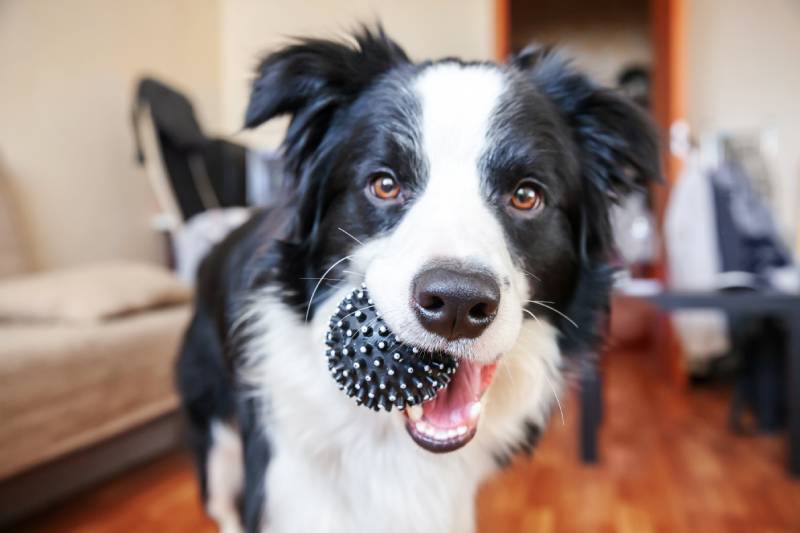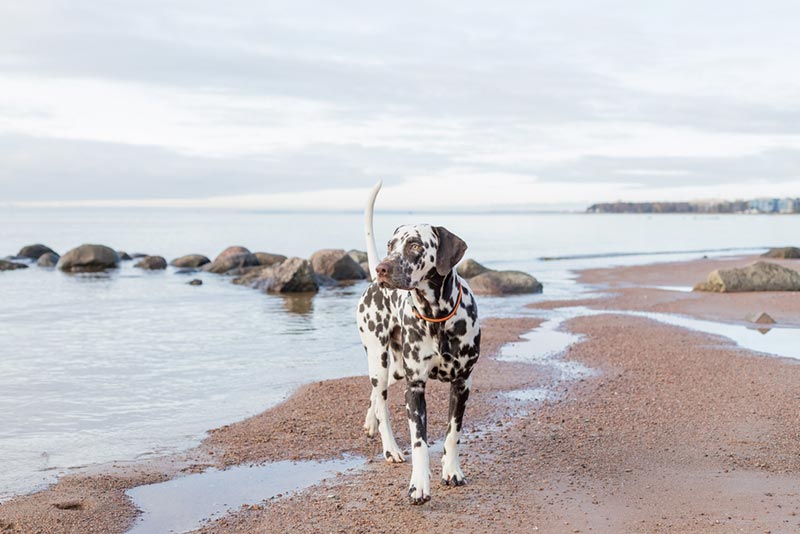Australian Goldendoodle: Pictures, Care Guide, Temperament & Traits
By Kit Copson
Updated on

Australian Goldendoodles—also known as “Double Doodles”—are dogs with an Australian Labradoodle and an English Goldendoodle parent. Altogether, this means that they’re a mix of Labrador Retriever, Cocker Spaniel, Poodle, and the English Cream Golden Retriever, which is lighter than the American Golden Retriever. However, Irish Water Spaniel heritage is also possible on the Australian Labradoodle side.
Poodle mixes have grown in popularity in recent years thanks to their adaptability, high intelligence, and family-friendliness, but what is it that makes the Australian Goldendoodle special? Read on to find out all there is to know.
| Height: | 20–24 inches, also comes in mini, medium, and tiny sizes |
| Weight: | 50–90 pounds, but tiny/mini varieties will likely be around 10–25 pounds, and medium somewhere in between (please note that breeders use different terms for size—some refer to medium dogs as “mini” or “medium/mini” and miniature dogs as “tiny”. Others stick to “standard”, “medium” and “mini”.) |
| Lifespan: | 10–15 years |
| Colors: | Various colors are possible, including cream, red, apricot, chocolate, champagne, phantom, caramel, merle, and tuxedo |
| Suitable for: | First-time dog parents, therapy dog training, anyone loving and committed |
| Temperament: | Vivacious, friendly, goofy, gentle, intelligent, loving |
One of the best things about mixes like the Australian Goldendoodle is that they come in all shapes, sizes, and colors thanks to their diverse parentage. This can also depend on breeder preferences; some may favor certain colors or sizes and develop their dogs based on these preferences. The coat is typically wavy, but it can also be curly, wooly, or straight depending on the parentage.
Australian Goldendoodle Breed Characteristics
Australian Goldendoodle Puppies
If you purchase an Australian Goldendoodle puppy from an experienced and reputable breeder (avoid backyard breeders), the fee could be anywhere from $2,500 to $3,500, give or take a few hundred either way. This is a pretty typical range for doodle mixes.
In addition to the initial cost of the dog, there are the setup fees (food, bedding, harnesses, etc.), and basic medical procedures (spaying/neutering, vaccinations, flea and tick treatments, etc.) to consider.
If you’re open to other mixes and breeds as well, why not head over to a rescue organization’s website to see who is up for adoption? Even if you don’t find an Australian Goldendoodle specifically, you may find some other lovely Poodle/Golden Retriever mixes.

Temperament & Intelligence of the Australian Goldendoodle
The Australian Goldendoodle’s heart-melting, gentle teddy-bear features reflect what they’re like on the inside, too. Based on what breeders and owners have to say about these dogs, Australian Goldendoodles have excellent temperaments. They have been described as playful, loving, gentle, intelligent, and eager to please.
Are These Dogs Good for Families? 👪
Yes. Australian Goldendoodles typically fit perfectly into family life, including in families with children because they’re such sweethearts. Of course, proper socialization plays a major role in how a dog behaves around family and other people, but as long as you’re committed to socialization and training, an Australian Goldendoodle should be a wonderful family member.
It’s also important to make sure everyone in the home treats the Australian Goldendoodle with respect. Your breeder or adoption organization should be able to advise you on whether they think an individual dog would be a good match for a home with kids.
Does This Breed Get Along with Other Pets?
According to Australian Goldendoodle breeders, these dogs are great around other pets. Nevertheless, you’ll need to take the time to introduce your puppy or adopted adult to your current fluffy family companions gradually and under close supervision.
It can be difficult for resident cats and dogs to accept a new family member at first, so go slowly to make the transition as stress-free as possible for everyone. Again, speak to your breeder or adoption organization about whether specific matches would be a good idea.
Things to Know When Owning an Australian Goldendoodle:
Food & Diet Requirements 🦴
Keeping your Australian Goldendoodle in good shape is key, as obesity, which is the most common yet preventable health condition in North America, can cause some serious health issues down the line. Dogs are omnivorous and will need a high-quality, nutritionally complete, and balanced food formula that’s measured and portioned out daily based on the packaging guidelines or your vet’s advice.
There are a multitude of complete and balanced options for dogs, some suitable for all sizes and some formulated specifically for small, medium, large, and giant breeds. There are also options that target certain areas of health, like, for example, weight management, joint function, and urinary health. If you’re not sure which brand would be best for your Australian Goldendoodle, please ask a vet for recommendations.
Exercise 🐕
Each dog will differ in terms of how much exercise they need (this can also be influenced by health status), but most adult Australian Goldendoodles have moderate exercise needs.
As an estimate, they’ll need around 45 minutes of physical exercise on a daily basis, but you can certainly change this up depending on your dog’s energy levels and their age—puppies should be exercised more gently at first, with the length of exercise time gradually increased as they get older, to reduce the risk of joint damage.
Fun physical activities for the easy-to-please Australian Goldendoodle include a few daily walks, fetch, chase, agility training, and games like frisbee, tug-of-war, and fetch. Some may also enjoy swimming, but not every dog does. In any case, be sure to kit yours out with a canine life jacket if they’re going for a splash.
Training 🎾
Dogs are the most receptive to training when they’re puppies, so, if you’ve brought home a puppy, it’s best to get into basic training immediately. Australian Goldendoodles are, by and large, considered to be highly trainable and eager to please, so they should respond well to short training sessions daily with a consistent leader who provides positive reinforcement (praise, treats, etc.).
If you’ve adopted an adult, don’t worry—adult dogs can also be trained, it’s just that it may be a little harder, especially if the dog hasn’t received much socialization and training in the past. Patience, consistency, and kindness are especially important for adult rescue dogs.
Grooming ✂️
Australian Goldendoodles are typically low-shedding (this shouldn’t be taken to mean that they don’t shed at all—all dogs shed to an extent), but the type of coat your Australian Goldendoodle will have will depend on their parentage.
If they have stronger Golden Retriever or Labrador Retriever genes, they’re more likely to have a straight coat. On the other hand, if the Poodle genes are stronger, a curly or wavy coat is more likely. If your Australian Goldendoodle has a coat similar to a Golden Retriever, the rate of shedding may be higher than that of a wavy or curly-coated Australian Goldendoodle. It really depends on the genetics.
In terms of coat care, it’s a good idea to brush your Australian Goldendoodle through regularly—at least every other day, but ideally daily—to prevent matting, tangling, and clumping. Poodle-type coats are especially prone to these problems, especially around the neck and tail base, so be sure to focus on these areas.
Regular nail trimming is another essential part of grooming, as too-long nails can quickly become sore. If you do this yourself at home, avoid the quick, which is the pinkish part of the nail. Cutting into this will be very painful, so keep the clippers only on the ends.
Health and Conditions 🏥
You can reduce the risk of getting an unhealthy dog by making sure that if you go to a breeder, it’s one that screens for genetic health conditions. If you adopt your dog, you should learn as much as you can from the adoption organization about the dog’s health status or any known potential conditions they might suffer from in the future.
According to PetMD, the following conditions are ones to watch out for in Goldendoodles. Note that the PetMD post is about Goldendoodles, not Australian Goldendoodles specifically, but Australian Goldendoodles might be susceptible to some of the same conditions since they share Goldendoodle parentage.
Before you panic, this in no way means your Australian Goldendoodle is going to develop these conditions, it’s just a heads-up of what to keep an eye out for, just in case.
- Mild allergy symptoms that receive treatment
- Minor, occasional stomach upset
- Hip dysplasia
- Heart disease
- Glaucoma
- Cataracts
Male vs Female
Genetics and socialization play the biggest roles in defining a dog’s personality, not breed or gender, so it’s really a case of getting to know a dog to find out if you’d be a good fit for each other.
The main physical difference between males and females is that males tend to be a bit bigger and heavier. When a male dog is unneutered, hormones can cause him to perform certain behaviors, like marking areas and objects with urine, mounting, roaming, and becoming more territorial.
Females in heat (unspayed) may be more irritable than usual, or, conversely, more clingy. They also are more prone to roaming and urinating regularly. Spaying and neutering can help reduce hormone-related behaviors and prevent certain cancers related to the reproductive system, like testicular cancer in male dogs and mammary cancer in female dogs.
3 Little-Known Facts About the Australian Goldendoodle
1. Australian Goldendoodles Make Wonderful Therapy Dogs
Doodle hybrids like Goldendoodles are often chosen to be trained as therapy and service dogs thanks to their gentleness and trainability. They also tend to be very devoted, enjoy pleasing their families, and have a real knack for putting a smile on your face, which are perfect therapy dog traits.
2. Australian Goldendoodles Are Great First-Time Dogs
Some dogs are a bit of a challenge for beginner dog parents, for example, due to their size and strength or tendency to be strong-willed during training. Australian Goldendoodles are usually good for first-time owners because they tend to be mellow and eager to please.
Nevertheless, it’s important for you as a first-time dog parent to be committed to consistent training and socialization, and to not let your Australian Goldendoodle bowl you over (too much) with their cuteness during sessions!
3. Australian Goldendoodles Like Having a Job to Do
The breeds that go into making an Australian Goldendoodle all come from working backgrounds. For example, Poodles once commonly worked as water retrievers, as did Golden Retrievers, and Labrador Retrievers and Spaniels have also worked closely with hunters throughout history.
For this reason, don’t be surprised if your Australian Goldendoodle likes having a sense of responsibility! Jobs you can teach your Australian Goldendoodle to do include fetching and carrying items for you around the house, finding something, and tidying up their own toys.
Final Thoughts
Like most doodle mixes, Australian Goldendoodles are known for their gentle and playful personalities, love of having a job to do, and suitability for all kinds of loving families. That said, getting a dog, whatever the breed or size, is not a decision to be taken lightly, and only those who are committed to raising a well-mannered, friendly dog while providing plenty of love and attention can make it work.
Read Also:
- English Goldendoodle: Pictures, Care Guide, Temperament & Traits
- Phantom Goldendoodle: Facts, Origin & History (With Pictures)
Featured Image Credit: You are free to use this image but we do require you to link back to Hepper.com for credit













